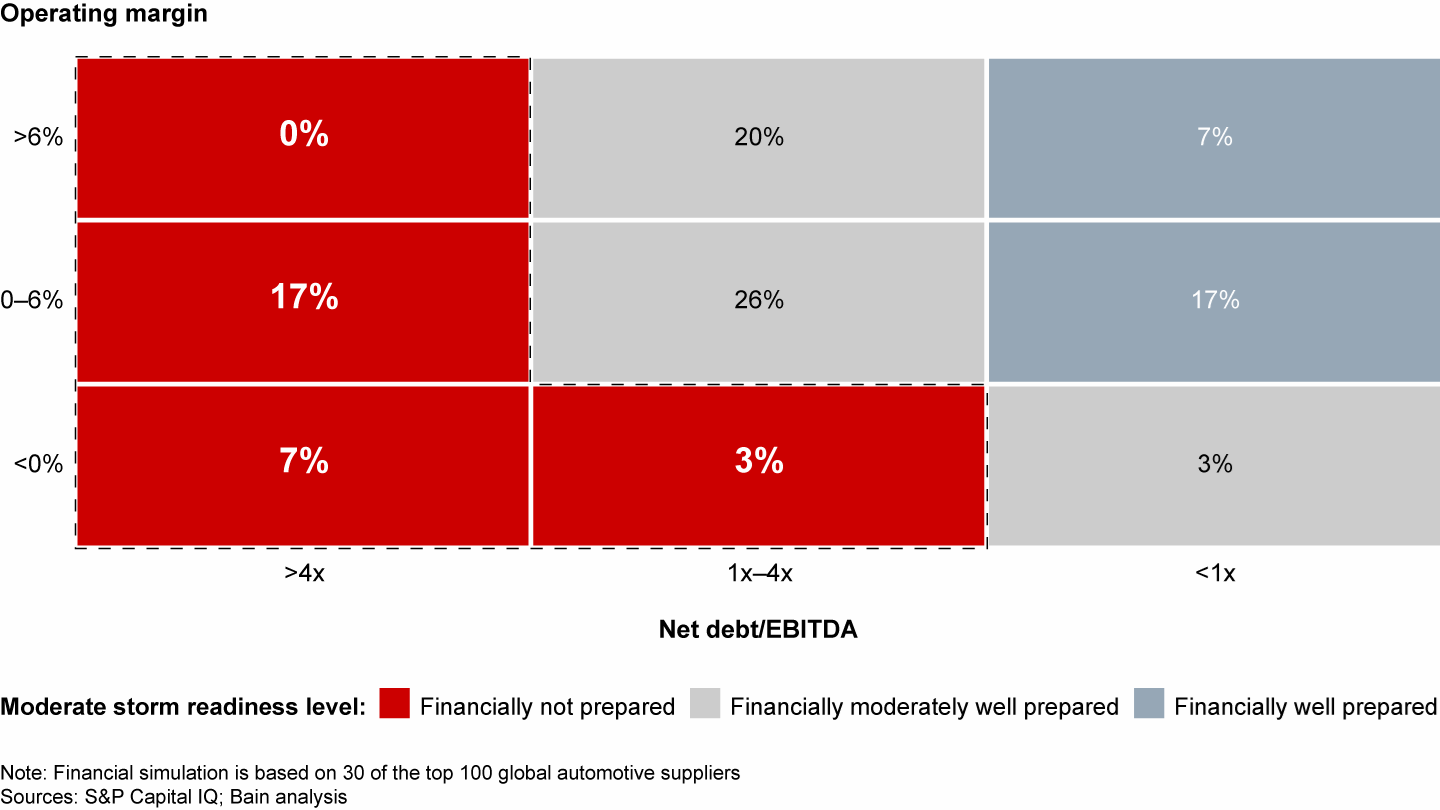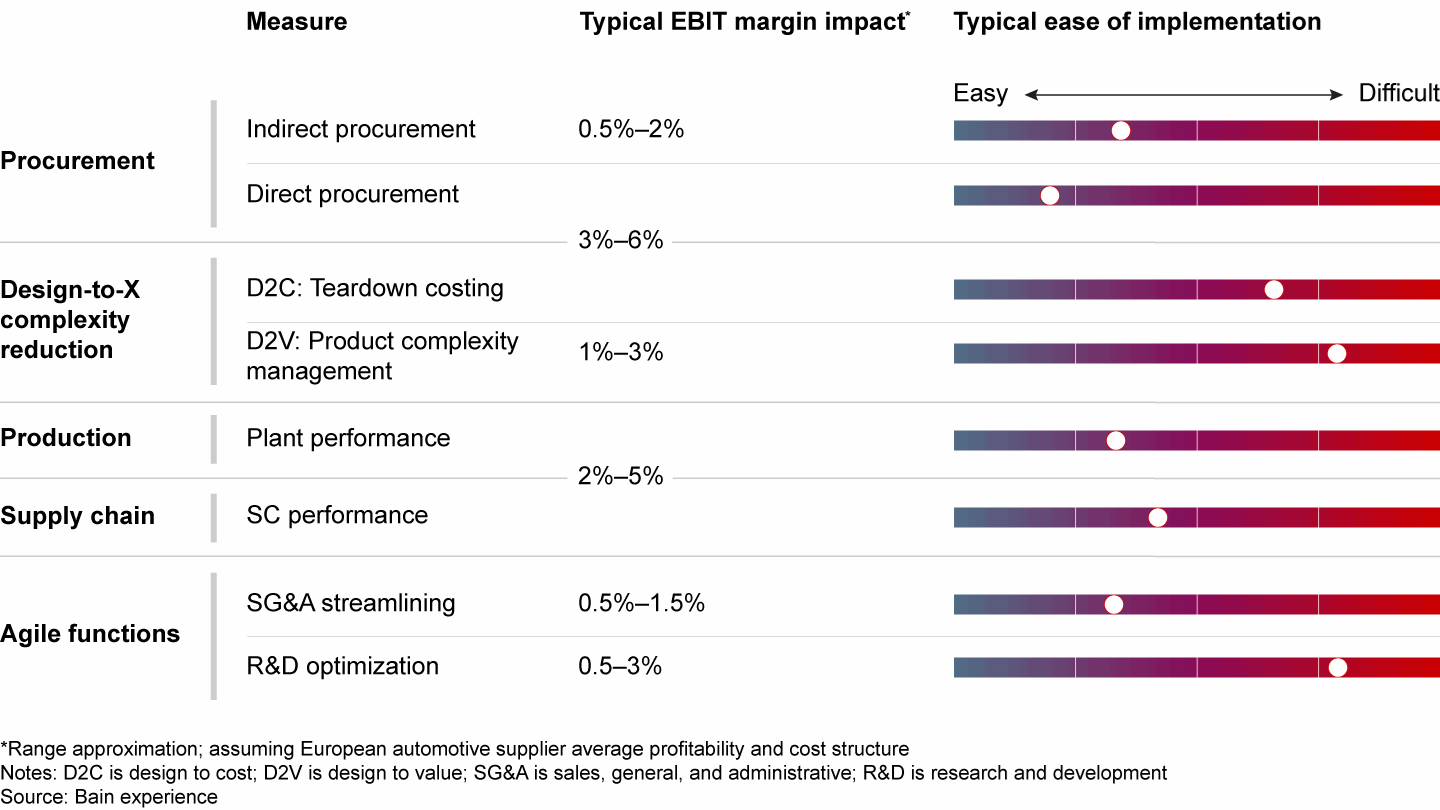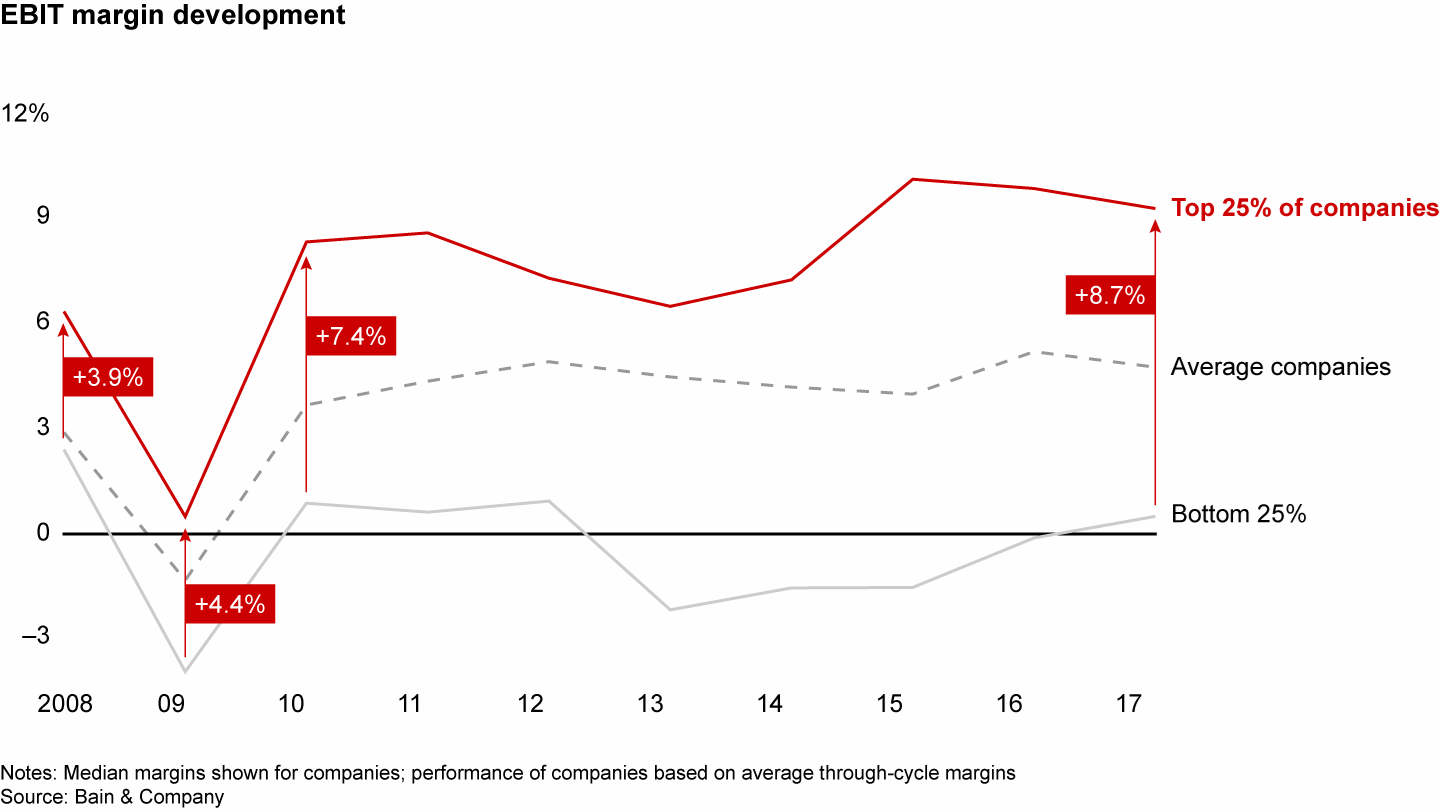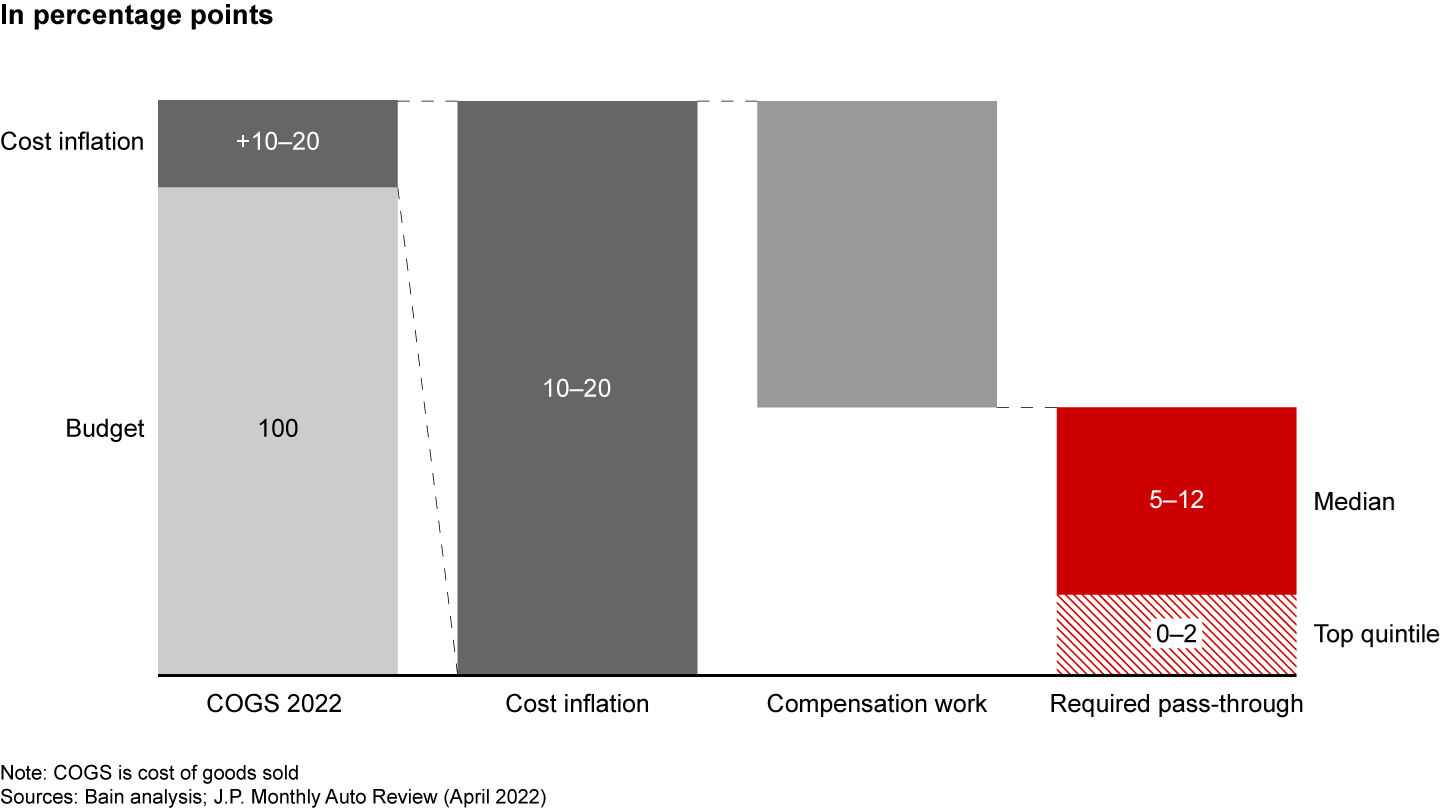Brief

한눈에 보기
- Auto suppliers must further transform their cost structures amid downturns, rising interest rates, and surging inflation.
- Increasing flexibility is a key success factor in times of high and continued uncertainty.
- At the same time, suppliers need to deal with the seismic and permanent changes reshaping the auto industry.
- To survive, an integrated response fusing cost reduction, commercial excellence, and the right portfolio strategy is needed.
Automotive suppliers’ profit margins are under extreme pressure after more than two years of stop-go production and little flexibility from original equipment manufacturers (OEMs) on pricing. Volatility has become the norm in the face of continued supply-chain challenges, record-high material and energy costs causing soaring inflation, and growing geopolitical tensions. As a result, many companies in the sector are in a significantly weakened position. Many are also highly leveraged, particularly among midsize suppliers.
With interest rates rising and banks more reluctant to lend to an already highly geared industry in so much flux, auto suppliers face being further squeezed by higher borrowing costs. At the same time, sales volumes remain volatile and will be impacted by downturns in several geographies.
Pressure to invest in expensive and unfamiliar new technologies for the future is also increasing, as the car industry shifts irrevocably to electric, autonomous, connected, and shared vehicles with software as a defining component.
The shift to electric vehicles (EVs), for example, is happening faster than expected even two to three years ago, and many OEMs have announced accelerated and ambitious targets. Volkswagen, for example, aims to get at least 70% of its sales in Europe from all-electric vehicles by 2030, and GM has pledged to sell only zero-emissions light vehicles by 2035.
In short, suppliers find themselves in a perfect storm. An integrated response is required to address the immediate pressure to protect their cash position and set them up for long-term profitable growth in the new reality.
Storm damage: Are suppliers prepared?
To better understand the potential impact of the current economic challenges on the supplier industry, we assessed supplier readiness for a “moderate storm” scenario in which global production volumes are flat, supplier costs increase by 7% (but only 4% of price rises can be passed on to their OEM customers), and financing costs increase by 20% as a result of hikes in interest rates.
We evaluated the ability of suppliers to generate healthy operating margins as well as handle their debt in this scenario. Our analysis of 30 of the top 100 global suppliers shows that about a quarter of leading auto suppliers are not prepared for such conditions (see Figure 1).
About a quarter of leading global auto suppliers are unprepared for a “moderate storm”


Setting the right course
These figures show the considerable urgency for auto suppliers to fundamentally adapt in order to avoid running out of cash, manage their debts, create enough balance sheet flexibility to invest in the technologies needed for the future—and ultimately keep control of their business.
An integrated response to the perfect storm has four key elements:
1. Fundamentally resetting costs now to ensure future viability
The most significant change that suppliers can make is around cost management and operational excellence, to ensure the structural viability of their business. Undoubtedly, suppliers have already worked hard to streamline their operations in recent years, but the severity of the current challenges is forcing them to the next level.
The most effective programs address purchasing, labor costs, financing costs, supplier selection and management, product complexity, design-to-cost decisions, and supply-chain operations. They also cut down sales, general, and administrative (SG&A) costs, and redesign the manufacturing footprint to remove excess capacity, which reduces the fixed cost base and improves flexibility in the face of volume uncertainty.
In procurement, successful suppliers strive to further optimize their supply base and consolidate volumes among a set of strategic partners, to further drive productivity improvements and realize the benefits of scale.
They also seek to analyze, monitor, and control material costs more stringently, using cost-regression analytics or cost-engineering practices—for example, design-to-cost and design-to-value, based on product teardowns and benchmarking. Suppliers currently have a window of opportunity to intensify design-to-cost activities because OEMs realize that suppliers need to improve their cost base to get back on a sustainable, profitable footing. As a result, they are more likely to support and approve cost-efficient design changes.
In our experience, the margin improvements that can be expected from each measure vary significantly (see Figure 2).
Measures are not cumulative, as profitability effects can overlap


There is no time to lose, but change can happen fast. In a recent cost-transformation project we worked on with an auto supplier, the transformation contributed $200 million savings in the first year with an annualized run-rate improvement of $400 million, resulting in an overall margin improvement of over 4%. The biggest initial improvements were in purchasing and pricing, while in subsequent years the key action that reduced the fixed cost base was consolidating the manufacturing footprint.
Suppliers who proactively restructure their business and take far-reaching action to reset costs during periods of disruption have a unique opportunity to improve their performance and distance themselves from competitors. Our research into the performance of suppliers during the 2008–09 financial crisis shows companies made dramatic gains and losses during and after the downturn. Those with a high level of agility in cost restructuring massively outperformed their competitors when the economy bounced back (see Figure 3).
Suppliers with high agility during the 2008–09 crisis outperformed their competitors in the following upswing


2. Sharing the cost burden
Up to 2019, suppliers’ EBIT margins were on average 1 to 2 percentage points higher than those of OEMs. Then came massive supply-chain disruptions with the chip shortage hitting in 2021, plus higher raw materials and energy prices, and now rising borrowing costs and wage bills due to inflation. OEMs were able to ride out the supply shortage by focusing production on the highest-margin models and raising prices, but suppliers had no such strategic options.
With the cost of goods sold (COGS) running 10%–20% above budgets on materials, energy, and labor costs in 2022, suppliers are under immense pressure. Yet to date, they have not been fully able to pass along their input cost increases to OEMs. Preparing for negotiations on cost pass-through—whether as price increases or temporary surcharges—is a truly cross-functional exercise for suppliers. It requires close identification of materials, energy, and labor cost increases and transparency in disclosing them.
A disciplined, intelligent negotiating approach is the second key part of an integrated response to the perfect storm. Suppliers can secure valuable relief for their financial position, and improvements are achievable (see Figure 4).
Suppliers need to pass through parts of cost inflation to minimize margin deterioration


Our research shows that a fifth of suppliers are able to recover around 70% of their additional costs from inflation, while the majority achieve lower cost pass-through levels of 40%–50%. The most successful companies have been able to realize price increases in the low double digits in 2022.
In a transformation project with a global auto supplier that was suffering a profitability and liquidity crunch because of volume losses and massive cost inflation, the company was able to achieve price increases of greater than 10%. In combination with a comprehensive bottom line optimization, this resulted in a double-digit EBIT uplift within the first year.
Ultimately, success on passing through cost increases comes down to suppliers demonstrating the value of their components and working relentlessly to prove that they are fully committed to reducing costs to benchmark levels. They must also be able to show that finding and switching to another supplier would cost the OEM even more and cause further implementation risks. Suppliers in distress need to show transparently that they continue to be a reliable partner, but in the current situation cannot succeed without support from the OEM to share some of their increased cost burden.
3. Stepping cash management and balance-sheet flexibility up a gear
For many suppliers, managing supply and demand through the high volatility of the past two years has been extremely challenging, making cash management a top priority. To survive the disruption of Covid-19 and the chip shortage crisis, suppliers took steps to rapidly stabilize their near-term cash position—including building cash war rooms to take control of liquidity and conserve cash—while centralized teams enabled rapid, real-time decision making and clear oversight.
Given the high levels of gearing among auto suppliers, the impact of interest-rate rises and increasingly cautious banks cannot be underestimated. Stepping up efforts to generate and conserve cash and ensure a degree of balance-sheet flexibility will be essential both to maneuver through the difficult months ahead and to allow companies to invest in the technologies that will keep their business model relevant in a transformed car industry.
Suppliers are building up sustained cash-management capabilities to ensure they have the headroom to get through the ongoing period of volatility. Profit-and-loss scenario modeling and improved liquidity forecasting are key parts of this change, plus better net working capital (NWC) management, for example, by reducing inventory held as “safety stock.”
We worked with one top-10 automotive supplier on a liquidity review as a result of disruption during the pandemic, and were able to reduce NWC by 30%, or €4 billion, through better stock management between the company’s plants and by lowering inventory.
When the company draws up its integrated transformation response, defining the financing requirements of the business going forward will also be key. Building balance-sheet flexibility starts with reviewing upcoming debt maturities and considering raising finance early—ahead of further rate rises and any further economic downturn. For suppliers who have the option, drawing down unused credit facilities will also build a cash buffer.
The priority for suppliers is to proactively do their own restructuring. Liquidity decisions are therefore underpinned by the fourth strand of the integrated response: the right strategic foundation. This will direct spending to the future areas of growth and enable even deeper cuts in areas that are no longer a priority.
4. Setting businesses up for the electric and software-driven future
The three responses above are bound together by the fourth: the right strategic foundation. While companies are taking rapid action to fundamentally reset costs, improve pricing, and aggressively manage cash, they must do so with clear targets for the future in mind. What does the future portfolio of businesses, products, regions, and customers look like after the transformation? This will also make clear which parts of the business have no profitable future and should be divested.
The long-term transition to EVs, the growing importance of software for autonomous driving, new profit pools in mobility services, and growing competition from new market entrants will all be front of mind. Responding to these transformational trends will inform suppliers’ M&A roadmap, capex priorities, customer targets, and to what extent to make or buy software.
In a time of profound uncertainty and volatility, suppliers can take three key actions now to set the right strategic direction for their transformation and long-term profitable growth:
- Evaluate each business in the portfolio based on margin, profit growth, and relative market position, to gain clarity on the future-readiness of every part of the company.
- Examine how to increase profitability even further from businesses that score highly in all areas through operational and commercial excellence, product refinements, and innovation, including exploring new avenues of growth.
- Explore acquisition opportunities to build or strengthen leadership positions in the most attractive areas or to acquire access to new technologies and capabilities. At the same time, make the call to exit parts of the business that have no clear path to target profitability.
Assessing growth opportunities in this way will also help suppliers understand where not to cut, even while taking radical action on operational costs and cash management, as outlined above. Our extensive experience of strategy-led funding projects in the supplier space, exploring how to focus R&D and capital expenditure to win, shows focused investment will help companies accelerate out of the downturn.
Survival and future success require radical transformation now
Automotive suppliers have no choice but to act now to transform their operations to survive the perfect storm reshaping the car industry. The scale of the challenge is enormous: Companies have hard choices to make to preserve cash in the immediate term, while at the same time setting their businesses up structurally for sustained, profitable growth.
There is no one universal answer. Yet with no going back to the way things were, pursuing operational and commercial excellence and increasing leverage with OEMs will be critical to ensuring auto suppliers’ survival and positioning their portfolios to take full advantage of a remade auto industry in the years ahead.
The authors are grateful for the support Ingo Stein provided to this study.